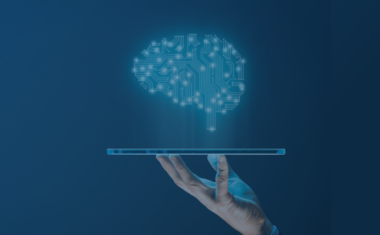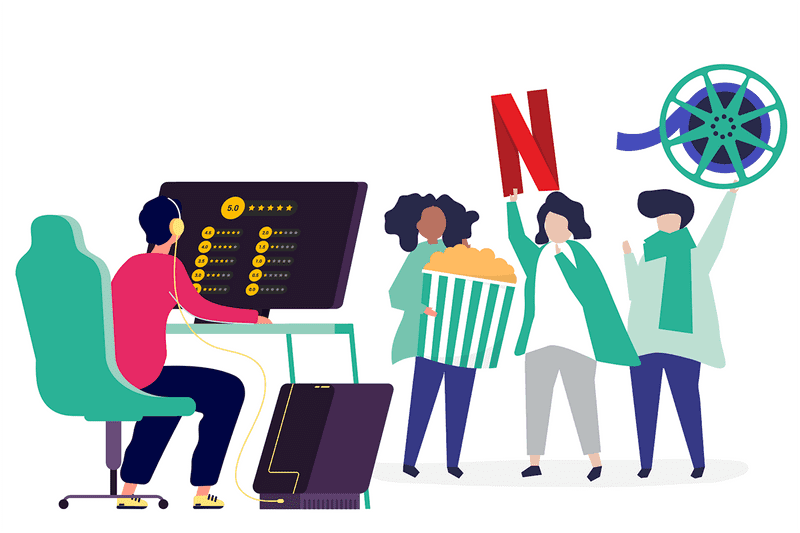Jobs that require a knowledge of Python are increasing each year, and as recently as 2020, it was voted the most popular programming language. The job market for Python programmers has not stopped growing in recent years and still shows no signs of slowing down. With so many different use cases, Python is in high demand, and experts predict that it’s going to stay that way.
Because of this, Python-specific interviews are becoming increasingly common, and given that Python is such a highly versatile language, preparing for a Python-related interview can be difficult.
That’s why we’ve put together a list of some of the most asked questions in a Python interview, along with their answers. Study these, and you’ll be one step closer to acing the interview.
What’s the Best Way To Practice Python Interview Questions?
The best way to practice for a Python interview is to practice coding with Python because there’s no real substitute for having a deep knowledge of a programming language. But it’s also a good idea to practice mock interview questions so that you know what to expect during the interview, and so that you can give succinct answers.
Conceptual Python Interview Questions
Here are some of the most commonly asked python interview questions:
What is Python?
Python is one of the most popular programming languages and has many use cases. It’s an interpreted object-oriented programming language and is considered a high-level language. Python has applications in many different fields, from software engineering to data science. As a highly versatile language, it is a useful language to know in most positions related to software development, as it can complete tasks from application development to data analysis.
Python is a free and open-sourced language that has a lot of community support and many packages that are available within its large standard library. Over the years, a number of tools have been developed that allow higher-level, more complex problems to be solved than were possible in the past. This means that you have little need for external libraries, as much of Python’s standard library provides the functionality that you need. As a highly extensible language, programs written in Python can be easily transferred to other languages.
Name Some Common Native Data Structures in Python. Of These, Which Are Mutable, and Which Are Immutable?
The four built-in data structures in Python are lists, tuples, sets, and dictionaries. Some of the key differences between these types have to do with their mutability. Lists and dictionaries are both mutable data structures, meaning they can be altered after they are created. Sets and tuples contain immutable objects, meaning they cannot be changed after they are created. They contain iterable objects with no duplicate elements.

Sets and tuples are more selective than lists. This makes them more efficient and allows the programs that use them to run faster than they would with lists. Dictionaries use a key to reference their elements and are unordered with no duplicate elements. Their keys must be of an immutable type, as dictionaries themselves are mutable and key mutability could cause an issue with referencing elements within the dictionary.
The differences between different data structures depend on their use cases. Sets are used when you don’t want to duplicate your items and need a simple, fast option. Lists are a one-size fits all option that might not be as fast as some but are able to grow and shrink as needed. Tuples are ideal for fixed data and are faster options for large sets that are contained in square brackets. Dictionaries are great for when you need your data easily referenced by unique keys.
Can You Explain What a List and Dict Comprehension Is?
Both a list comprehension and a dict comprehension are single-line syntactic constructs that allow for efficient use of code to accomplish complex tasks. This is a much quicker way than many conditional statements, like for and if loops. They are examples of some of the many special functions that Python offers that can make processes simpler. An example of a dict comprehension can be seen in this list of prices in a list being changed from US Dollars to British Pounds.

The following is the output you would get:

As you can see, the new dictionary has been updated to reflect the items for the last dictionary with a slight modification made. This method is fairly lightweight and doesn’t require any complex programming to accomplish a simple task.
For an example of list comprehension, we can modify items in a list without the use of conditional statements.

Instead of a loop, we can carry the values over to a new list with the necessary modifications made.

Both of these options lower the amount of time per iteration and make more efficient use of memory. The for loop may take up more memory than the method that didn’t utilize a loop. However, they are both proper syntax that will return the right result and are usually used for the same purpose, just in different contexts. Many developers prefer the use of either a list comprehension or a dict comprehension as it allows them to create more time-efficient, more easily executable code that uses less memory. There may be some programs where a slightly slower program option is better as it will make more sense in the surrounding program’s structure.
What Is the Difference Between a List and a Tuple?
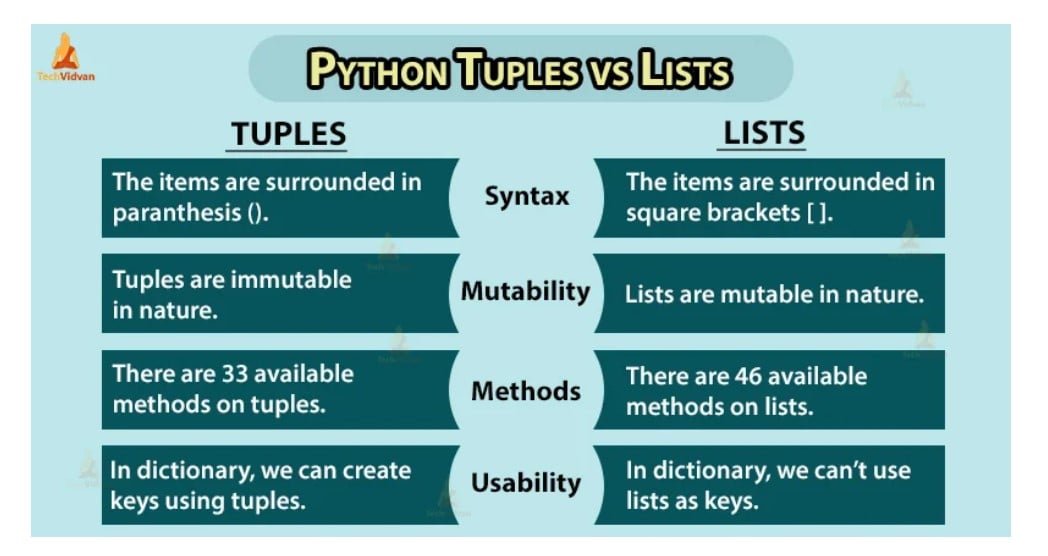
Both a list and a tuple are a collection of items. The main difference between list objects and tuple objects is mutability. While you can make changes to a list, a tuple contains immutable objects that cannot be altered. This generally makes a tuple a faster option that doesn’t use as much memory as a list. Another major difference is in how you define a list vs a tuple. When defining a tuple, you will use a pair of parentheses. When defining a list, you will use a pair of square brackets.

This numerical list of integers and the matching tuple would result in the following output:

A similarity that these two collection data types have in common is that they are both a sequence data types that can store a wide range of objects.
When Would You Use a List vs. a Tuple vs. a Set in Python?
The differences between these data types come down to what they are being used for. A list is a widely used data structure that is good for many uses. They are ordered, changeable, and allow duplicate values. If you are working with a data set that shares many of these same characteristics, but the data needs to remain unchangeable, then you should use a tuple instead. Tuples are also ordered and allow duplicate members but remain unchanged.
For the purposes of memory usage, a tuple is a data type that would likely be used for memory-heavy tasks. As it is more specialized than a list, it takes up less memory and allows for faster iterations. While lists can be used for these kinds of programs, they would likely slow the program down and would not be ideal for use on large data sets that require a significant amount of memory usage.
What Are the Typical Characteristics of Elements in a List vs. in a Dictionary?
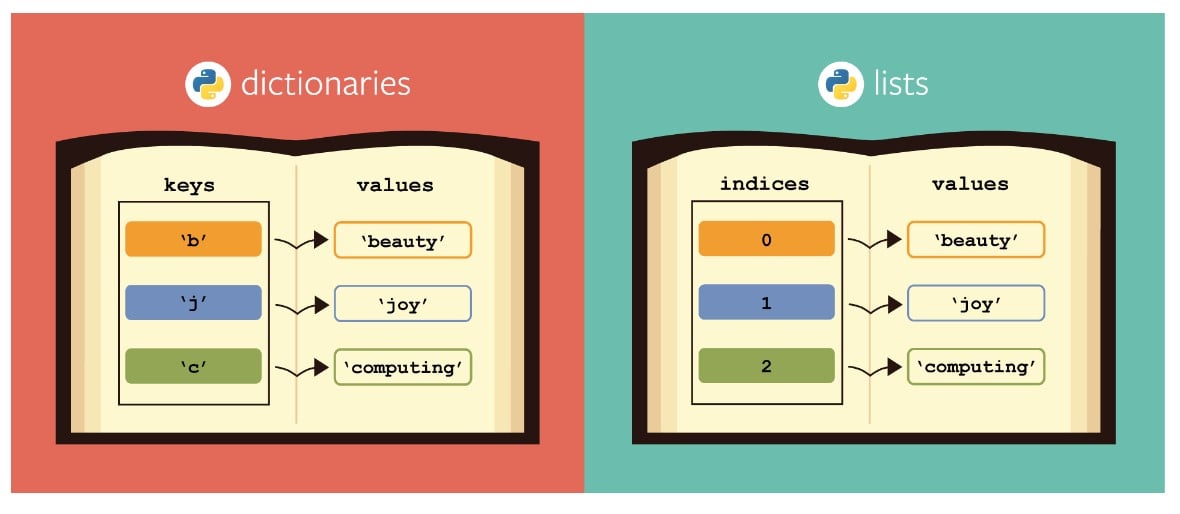
Elements in both Python lists and dictionaries are mutable and dynamic. They can both be nested and are both able to be indexed. However, it is important to note that the index for a Python dictionary is referenced with a letter. This index is actually called a “key.” A list index is referenced with a numerical value, with the first element in the list having a value of 0 and the second element having a value of 1, and so on. As of Python version 3.7, a Python dictionary is no longer an unordered collection. In versions 3.6 and before, they were considered to be unordered collections as the items could not be referred to with an index.
What is PEP 8?
PEP 8 stands for “Python Enhancement Proposal 8.” It is a document that was written by Guido van Rossum in 2001 that provides guidelines on how to write Python code. The key focus of PEP 8 is to enhance the readability of Python code in order to help facilitate consistency in how the code is structured. This allows for collaboration between developers. This standardization, along with the general simplicity behind the Python language, is one of the reasons Python is so widely used and popular with developers.
What Is Tkinter in Python Used For?
Tkinter stands for “TK interface” and is the most commonly used method to create Graphical User Interfaces (GUIs) in Python. As the only standard method that is built into Python’s library, it is the one most developers choose. By using Tkinter, developers are able to create desktop applications and other graphical interfaces.
What Is a Decorator?
In Python, a decorator function is a function that allows new functionality to be added to an existing object. This is done without any modifications being done to the structure of the object. Using a decorator function, a developer can use a function with some new features added to it while maintaining the integrity of that same function.
What’s the Difference Between A for Loop and a While Loop?
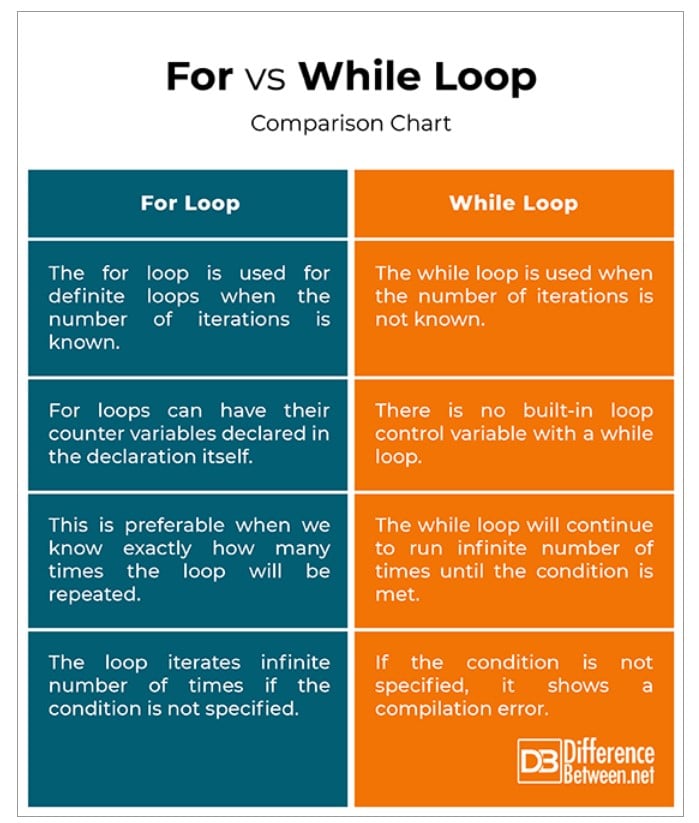
Loops are used to run a block of code over an iterable object. Both For and While Loops can accomplish this process with similar iterable objects. The main difference between the two is the number of iterations. It’s not always known how many times you’ll have to run a loop until the necessary result is reached. In these cases, a parameter will be set and a While Loop will run until the condition is met. Developers have to be careful to remember that, without a condition that stops the loop from running any further, a While Loop can become an infinite loop and will run until the entire program is terminated. This is not the case with a For Loop, which has a definite number of iterations that are easily established in the loop’s declaration.
Tell Us the Difference Between a Shallow Copy and a Deep Copy
The difference between a Shallow and a Deep Copy is what information is shared and carried over to the second copy. With a Shallow Copy, only the reference address is copied. With a Deep Copy, both the original object and all repetitive copies are copied and stored.
What Makes Python an Interpreted Language?
Python is considered an interpreted language because it converts its programs into bytecode that is then executed by a Python virtual machine. This process requires the deployment of an interpreter that helps to make the code from Python understandable and usable by your computer. This interpretation process carries out implicit type conversion automatically. Through implicit type conversion, the other interpreted programming languages include PHP, Ruby, and JavaScript.
Get To Know Other Data Science Students
Abby Morgan
Data Scientist at NPD Group
Jonathan Orr
Data Scientist at Carlisle & Company
Leoman Momoh
Senior Data Engineer at Enterprise Products
Is Python an Object-Oriented Programming Language?
Python is an object-oriented programming language. While it has the ability to also allow for functional programming, it is primarily object-oriented.
How Is Memory Managed in Python?
Python’s memory manager automatically allocates memory. Python contains a garbage collector that helps automate the reuse of all unused memory within a program. Objects are deleted from the heap memory as soon as they have no reference point. This allows memory to be freed up and allows for more efficient memory management.
Explain the Difference Between Pickling and Unpickling
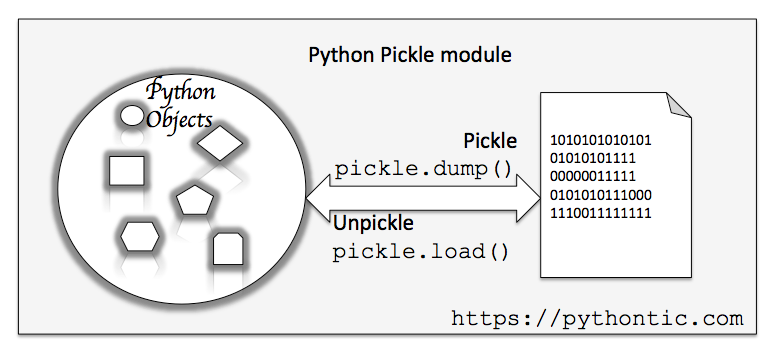
Pickling is the process of converting the hierarchy of Python objects into a byte stream, and then into a Python file as a string representation. Unpickling is the opposite of this process. Python programs run from source code files and are directly interpreted by the byte code. Once the virtual machine begins to move the objects from a specific program to the computer, the pickle module carries out a process of serialization of those objects into an understandable language that the computer can store through a dump function.
This dump function’s primary function is to convert the program to a Python file. Then, when a computer’s Python source code files begin to convert back, the unpickling process starts. This reverse process is also accomplished through the pickle module when the executable code is converted back and the string representations are turned back into the original Python object.
Name Some Packages From the Python Standard Library That Are Useful for Data Science Projects
A package in Python is a collection of items that is able to be imported into a program in order to help facilitate complex processes. Many of the packages in the Python Standard Library are helpful for data science purposes. Most of these packages utilize Python to develop machine learning algorithms, data visualization, exploratory data analysis, and neural networks. While it’s not necessary to know all of the packages in Python, a good knowledge of at least several options is highly recommended before you go into a Python interview. These are just a few of the many packages that are available.
Caffe
Caffe is a package that helps with image recognition processes. As a deep learning framework, it boasts a highly robust capacity that can process 60 million images a day.
PyTorch
PyTorch is a tool that helps in the building of dynamic neural networks. It has many features that make it a highly versatile option for those who are in need of a tool for deep neural network projects.
Theano
Theano is an open-source deep-learning library. While no more updates are being released on this package, similar frameworks exist that copy many of Theano’s functionality.
TensorFlow
TensorFlow is a widely used machine learning package that is considered one of the most famous. It’s a highly flexible option for data scientists who are specializing in numerical computation.
Keras
Keras is a popular tool that is built for experimentation. It is a deep-learning library that is popular due to its API, which is considered to be one of the more user-friendly options.
Pandas
The Pandas library is the go-to Python library for data analysis. It can be used for many different operations within the data science and data analytics specialty and is a popular option for large data sets. The Pandas library is one of the most popular options for data manipulation within Python. In order to import Pandas, the import statement “import pandas as pd” is used.
NumPy
NumPy is a package in Python that is used for scientific computing. As it was once part of SciPy, it shares many features. However, the two are optimized for different uses and were separated into two different packages in order to accommodate these differences. Through NumPy, you can get access to many scientific computing features that include linear algebra, basic statistics, and other mathematical functions. Universally named “np” when imported into a project, this tool is an easily accessible package. In order to import NumPy, use the import statement “import NumPy as np” at the beginning of a Python program.
Matplotlib
Matplotlib is a package that helps with data visualization and graph plotting.
SciPy
SciPy is a package that builds on NumPy. As a data science package, it also contains a number of sub-packages that contain many specialized scientific computing features. Like NumPy, SciPy is also used for basic statistics, linear algebra, and many other mathematical functions. It is widely considered a great option for those who need a one-stop shop for all of their scientific computing needs.
In Python, What Is a Lambda Function?
A Python lambda function is a function without any name or an anonymous function. A lambda function is an anonymous function due to it not having a function name until it’s assigned one. It takes any number of arguments and then returns a single expression. They are typically used in order to take up less space for an argument. The syntax for a lambda function consists of an argument and an expression separated by a single ‘:’ in the middle. There can be any number of arguments, but only one expression. For a lambda function, a return statement is not necessary, as it is able to return an expression on its own.
Distinguish Between “Is” And “==”?
In Python, the operator “==” compares the value of two objects. The operator “is,” on the other hand, determines if two variables are pointing to the same object. A great example of this concept can be found in the following programs:
In this example, the operator “==” is checking to see if these two objects are equal in value.

In this example, the operator “==” is checking to see if these two objects are equal in value.

In this example, the operator will check if “a” refers to the None object. It will perform no further purposes than this one purpose.
What Are Some of the Disadvantages of Python?
One of the most common complaints that developers have about Python is poor memory efficiency. Its inefficient use of memory can heavily tax your RAM and make it difficult to run Python-based programs without using significant portions of memory. Python can also run very slowly and, as a result, can suffer from runtime errors. This is largely due to how Python is interpreted and is something that can bother developers who are used to much faster languages like C++ or Java.
Most of Python’s issues are related to its versatility. While it is not optimized for one particular task, it is still a very flexible language. It’s through this flexibility that many use cases for Python have developed over the years, making it virtually indispensable in a developer’s portfolio. The disadvantages of Python make it a less-than-ideal language for developing web applications and for game development due to its poor memory management and slow processing speeds.
How Can You Combine Two DataFrames in Pandas?
There are a couple of ways that you can combine two Pandas DataFrames. The first way is to simply concatenate either the columns or rows of the Pandas DataFrames. As you’ll see in the example below, this is done very simply by using the concat() function:

This method will give the following result:

As you can see, this function takes the column from dataframe 2 and connects it to the end of the column from dataframe 1.
Another method involves using the append() function to concatenate. The code block below shows how this function can be used to join columns and rows together.

And the resulting table will be displayed:

While these two methods both work well, many developers prefer the concat() function over the append() function due to it being a faster option. While both methods work to combine Dataframes in the Pandas library, the decision ultimately comes down to context and functionality.
What Is a Namespace in Python?
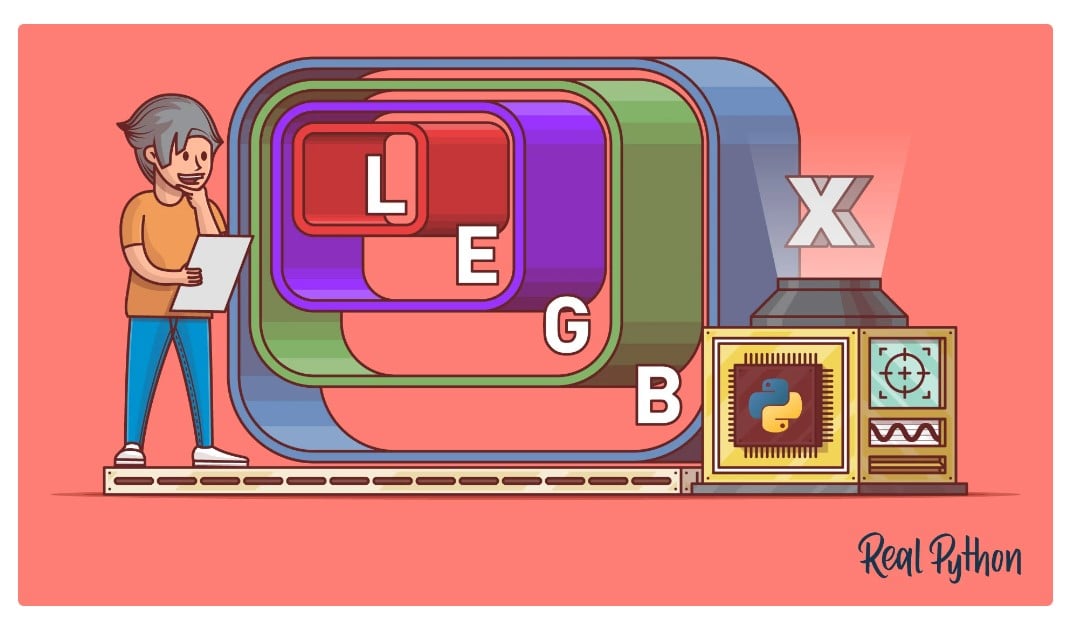
A namespace is a system that has a unique name for each corresponding object. It contains each variable that you have defined within a certain section of Python code. The hierarchy of namespaces within Python consists of 4 major levels:
- Built-in
- Global
- Enclosing
- Local
Built-in namespaces are the namespaces that are part of Python and are available the whole time that Python is running. A function within this namespace is known as a built-in function, and its objects are universal to Python code. Global namespaces are the namespaces that belong to the main program that runs when the interpreter begins to run. Enclosing namespaces and local namespaces are within individual programs and carry the values of variables and objects within the spaces where they are defined. Understanding the hierarchy of Python namespaces can help you understand the way that objects are named and the scope of variables in Python.
Describe Python’s Parameter-Passing Mechanism
Parameters in Python are passed by reference. What this means is that if a parameter reference is changed, it reflects back to the calling function. As all Python data types are objects, a parameter passing is passed by assignment. Both the new variable and the original variables in Python will end up pointing to the same object.
What Benefits Do NumPy Arrays Have Compared to Python Lists?
NumPy is one of the major scientific computing packages in Python. Sets of data are organized by using NumPy arrays instead of lists. Depending on what you are using this array for, it can be a far better tool than a list. Arrays only allow for one type of data to be contained within itself. However, lists can contain multiple data types and, as a result, consume more memory when they are used.
NumPy is designed strictly for computational purposes that are related to numerical values. As it is more compact than Python lists and can be used more efficiently, it is the preferred method for numerical calculations.
Distinguish Between a Module and a Package
If you want to make a larger block of code with a specific function more usable, you can separate it into a Python module or a Python package. This process has a number of advantages, namely that it allows for simplicity and reusability of objects. In Python, multiple packages can be contained in one Python module. The key differences between the two are that packages can contain several modules. A Python module is a simple source code file that allows for easy implementation of certain processes. Packages are created in order to contain multiple Python modules that could be utilized when needed once a package is imported using an import statement.
Coding-Based Python Interview Questions
Here are some of the most commonly asked coding-based Python interview questions:
Reverse an Integer
Reversing an integer in Python is accomplished very simply by converting the number into a string, reversing it, and then displaying the reversed result. This method can be seen in the following example:
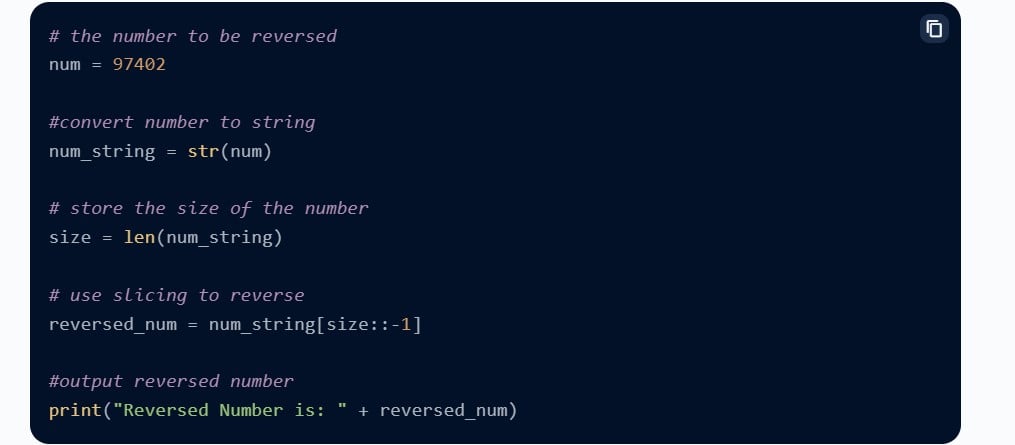
As you can see, the integer goes under type conversion to a string and is stored in a new variable. The function reversed() reverses the string, which is then printed out. An integer is a built-in type of data within Python. This same process can work for another built-in data type like a floating-point number.
Check if a String Is a Palindrome
There are several ways that you can use Python to check if a string is a palindrome or not. You can design a program that checks if a statement is a palindrome and returns true or false values, depending if it is or not. The first method employs an if statement to check if or not the user’s input can be reversed and retain its meaning. For this example, the word “malayalam” is input by a user.
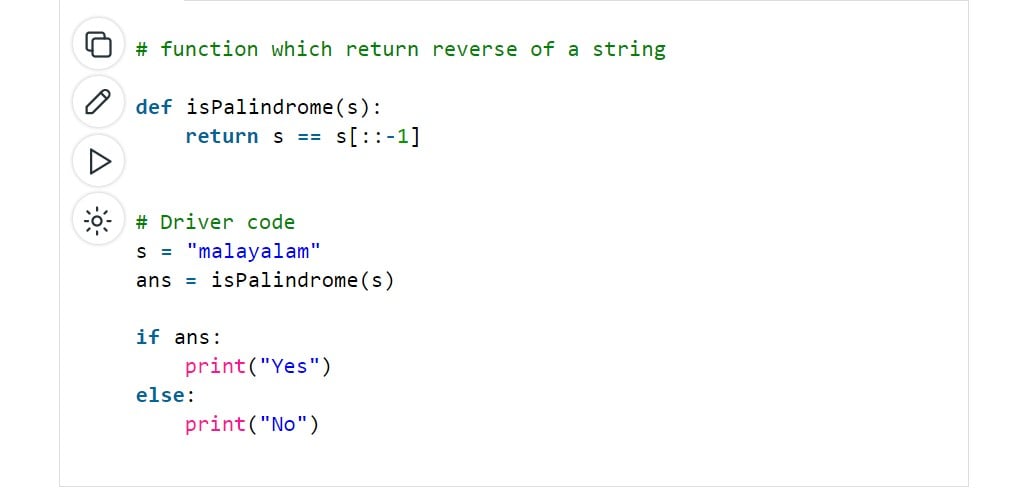
This program would return “Yes,” as the word “malayalam” can be reversed and still be read the same way. In this situation, the “Yes” is an indication of a true value.
The next method uses a conditional statement, which is, in this case, a For Loop to check if the word “malayalam” is a palindrome:
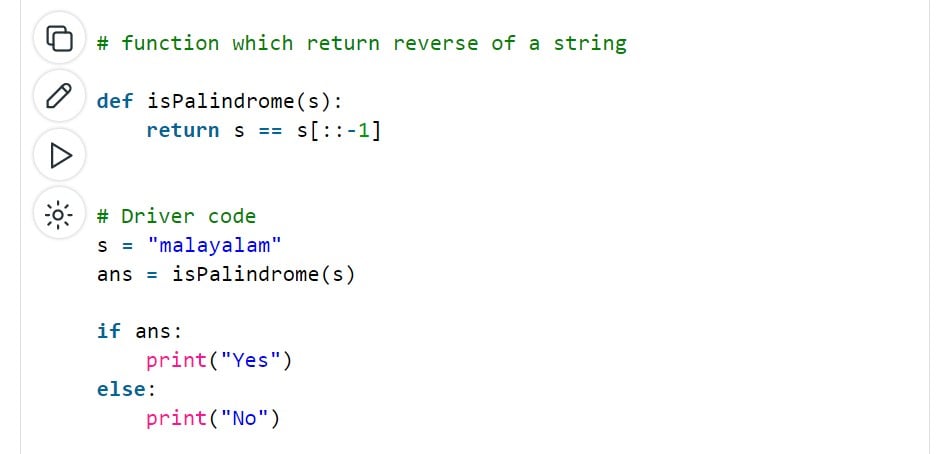
This is just another example of how to perform the same operation as the first method. For each of these programs, false values would be indicated by the program returning “No.” While there are many other options for checking if a string is a palindrome, these two examples show two very different methods that employ different tools to accomplish the same task.
Check if a String Only Contains Digits
You can do this with the str.isdigit() function. Using this function, a loop can be constructed that will return true or false values based on whether or not the string in question contains digits.
Convert Date From yyyy-mm-dd Format to dd-mm-yyyy Format.
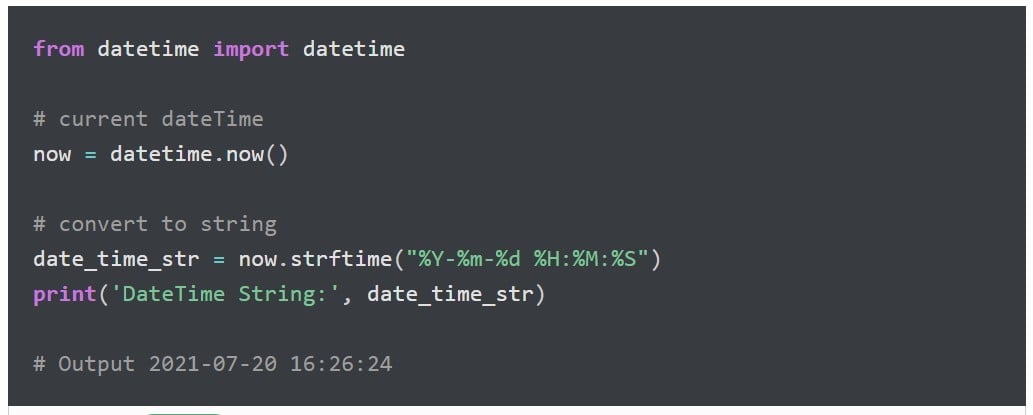
The process of converting the dates in Python from yyyy-mm-dd format to dd-mm-yyyy format involves taking the input for the date, then specifying the formatting of the date as being “%d/%m/%Y” within the formula .strftime(). The formatting is what matters in this program. Any date can be changed over to the dd-mm-yyyy format as long as it is specified within the formula.
Calculate Square of the Provided Number
There are many different ways that you can perform this calculation. This is a standard math equation that you can use in many different programs. For the first method, you can simply multiply the two numbers together:

This method will return the square but is limited to the raw input from the user. While that’s good for many use cases, it limits the numbers that can be multiplied by each other.
Another method is to use the inputted number and to use the two multiplication operators, and the number 2 to indicate that the number will be squared. This is a simple method that allows for the calculation of the square by using the variable “number” only once.

The last method is to use the math.pow() method, as seen in the example below:

Math.pow() will multiply the first variable in the argument by the power of whatever is put into the second part of the argument. You can use this method to calculate the cubed value, the 4th power, and so on.
Whichever method you will use depends on the context of that operation and what it is trying to accomplish. The best options are usually the options that use the least amount of memory and can be easily replicated or understood by your peers. This is why most companies attempt to standardize certain processes. Doing so makes projects much more communicable and allows for better collaborations between programmers.
Identify the Largest and Smallest Numbers in an Array
There are several methods that you can use to identify the minimum and maximum values in an array. This problem is especially valuable to be able to solve, as it shows up in many statistical analyses. Below are three options that you might use, depending on the situation.
The first method will use variables to store the maximum values and minimum values of the elements in the array.
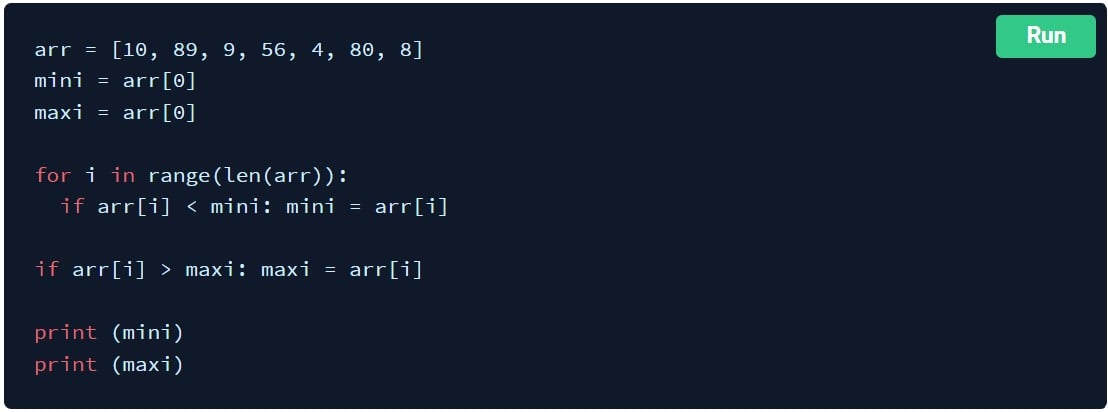
This program will return the numbers 4 and 89. Through this method, we can see that a For Loop can help us find the maximum values and minimum values of an array’s elements, and store them to variables that we can print, save for future use in the program, or both.
The second method utilizes the inbuilt .sort() function to find the value of the minimum and maximum values of its elements.

As you can see, using this method, we are able to shorten our program significantly and print the values directly. As this method does not utilize variables, we can print the minimum and maximum values but we cannot store them for later use. The print function would return the same values to us but we will not have those values stored.
The third method is one that utilizes the inbuilt functions min(arr) and max(arr).

This method is the shortest so far and only requires that the program print the min and max values directly. There are many different variations of each method that could be run, but each of these is a concise and efficient method to find and print the minimum and maximum values of an array.
Check if the Given Array Is Monotonic
There are a couple of ways that you can check if an array is monotonic. We’ll explore two methods for this question that you may get asked in a Python interview. For the first method, we’ll look at an example of a quick way to check if an array is monotonic:
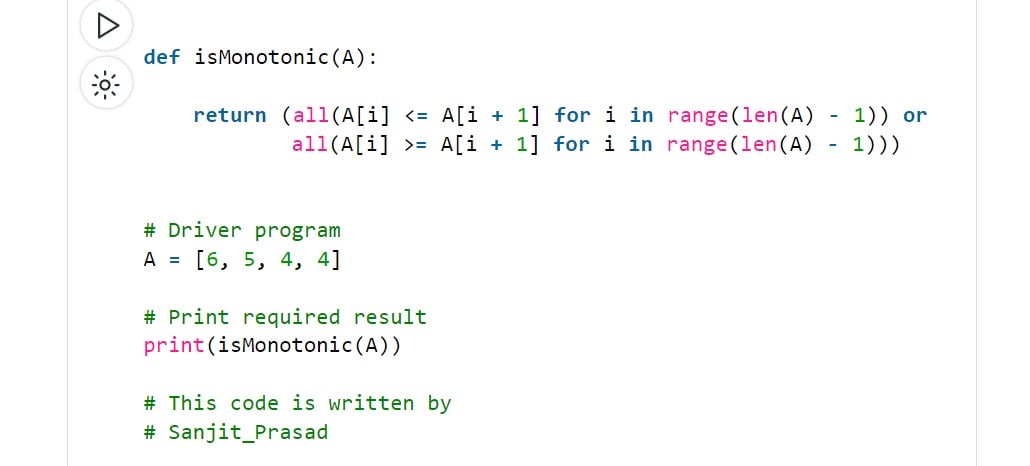
In this approach, an array is only monotonic if the monotone is decreasing or increasing. This is all done in just two lines in that initial code block. This approach accomplishes this check-in with very few lines of code, and with only one pass.
The next method that we’ll use for this example is a little bit longer:

This method utilizes a slightly longer approach where the array is separated into two new arrays that are then sorted into ascending and descending order. These arrays are then compared to the original array to see if they match. If either of them does, then it is determined that the original array was monotonic. This method employs a much longer code block to accomplish what is essentially the same process as the first method.
General Python Interview Questions
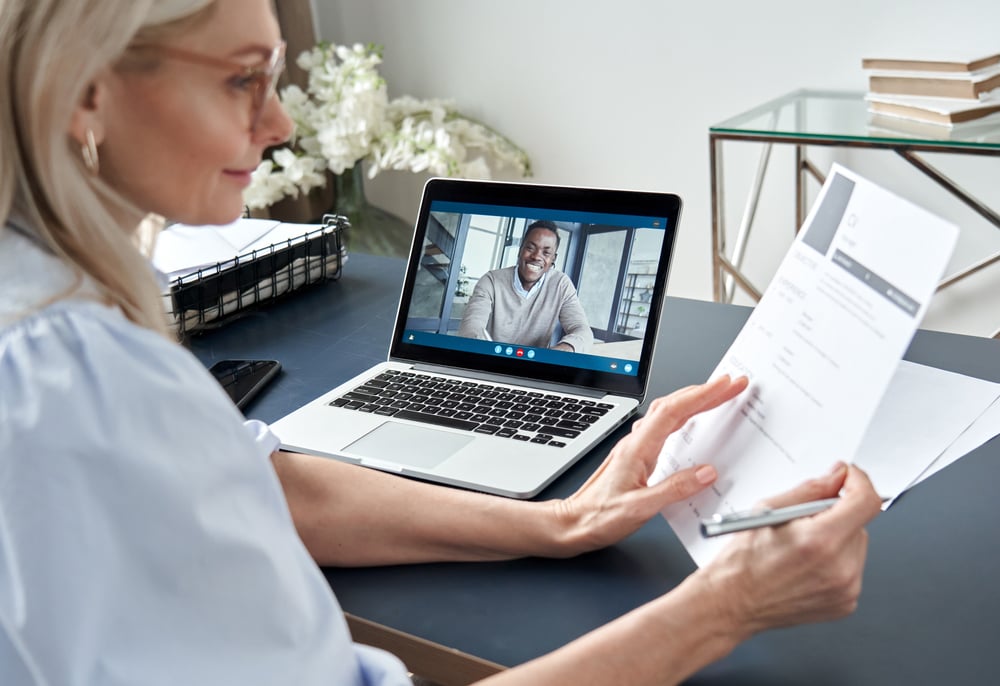
Most interviewers will want to know a little bit about your Python journey. Here are some of the most common questions you’ll be asked:
Tell Me About Yourself
This question is a great opportunity for you to highlight things about yourself that make you stand out in a crowd of applicants. Your background and your reasons for pursuing this career are both great topics to highlight during this portion of the interview. Let them know what kinds of things motivate you and what you do outside of work. Everyone has a unique part of their story. Find yours and let it help you stand out early on in the interview.
Another point to make a priority during this portion of the interview is why you are a good fit for the job. Your summary about yourself should end with why you are a candidate who will excel in that role and how you can bring skills and potential to the role. As the interview progresses, you’ll be asked more specifically about your qualifications. Take into consideration the fact these questions will be asked and state them upfront.
An example might be that you’ve recently passed a certain certification for data analysis with Python and SQL and that it was a great refresher for your knowledge of the many data-related applications of the Python language. This is just one example and is not an exact scenario. You may want to communicate projects that you completed several years ago or that you’ve worked in a similar role before. Whatever you choose to say, make sure that you point out that your candidacy for this role is evident in your experience.
Just like an introduction to someone you’ve never met before, this first impression is going to last. It needs to be a good one in order for the interviewer to be optimally engaged and enthusiastic about your joining the team. But at the beginning, you want to start with a good first impression of yourself.
What Have You Done To Improve Your Skills in Python?
One way to answer this question is to talk about any bad habits that you have when it comes to Python. It’s natural to have some concepts be difficult, and this is at the core of what the interviewer is trying to understand about you. Show off the parts of your work and education that contribute to a better understanding of Python and how to utilize it in projects and applications.
The best way to show that you’ve kept improving your skills is to leverage your GitHub account fully. Through your GitHub account, you can show your projects and your regular contributions to those projects. It’s a great way to showcase your knowledge of the Python language while also showing your commitment to increasing your experience and developing your knowledge of the Python language over time.
Use this feature of GitHub to show key differences between your past and current skill set. Take stock of the courses that you’ve taken and the certifications that you’ve passed in order to learn what you know about Python. Depending on what kind of role you are applying for, you will want to showcase education that is specific to that role as well. It isn’t hard to find great courses and bootcamps to help you develop your skills and specialize further.
Do You Contribute To Open-Source Projects? Have You Flagged Issues?
Not everyone has contributed to open-source work, and that’s perfectly fine. If you don’t have any examples of open-source projects that you have worked on, try to think of collaborative projects that you have helped develop and highlight your contributions to that project. What an interviewer is looking for when they ask this is specifically your contributions to the projects, not just a summary of the projects that you worked on. They want to know how you contributed and what your contributions did to help the project’s success.
The ability to troubleshoot and come up with solutions is a skill that many are looking for in an applicant. While many companies have standardized systems in place, they need people with the ability to catch problems and bugs that might be in a program that no one else noticed. Flagging an issue usually means that you’re engaged and interested enough in the project to raise the question and find a solution to a problem. This means that when you’re at work, you’re actively engaged and remain observant.
It’s also important to note how you went about dealing with an issue that you saw in the program. How you report an issue and how you discuss an issue are also key indicators of a growth mindset that doesn’t waste time blaming others or putting past team members down. Instead, the focus of the problem-solving mindset that interviewers are usually looking for is one that treats issues or bugs as simply part of the process and works with the entire team to fix them. Show your interviewer that you’re capable of positive communication, even while flagging a bug that might be a cause for a lot of extra work and irritation for you. This can be a great way to stand out from other applicants who may tend to blame their mistakes on others while trying to look perfect for the interview.
What Are Your Favorite Resources To Stay Up to Date on Python Developments?

Interviewers want to see continued education. When you are asked any question about your ongoing educational process, it’s usually done to get a better idea of how you operate and how much you do to upskill. Your personal growth as a developer doesn’t have to be anything extreme or impressive. As long as you show that you are always working to stay ahead of the curve then you are already doing more than many applicants. Specify to the interviewer what methods you use to develop your Python skills and how you went about building your portfolio.
There are many great resources for learning about Python and staying on top of your skills. The key is to keep a steady education process going well before beginning the interview process. By keeping up your education in advance you can ensure that you are able to communicate Python concepts well and are able to solve problems well using the Python language. There are many bootcamps, courses, and certifications available to help you learn and maintain your knowledge of Python over time. These resources are all great topics for discussion while explaining your education process.
Do You Have Any Personal Projects? Tell Me About Them
As a developer, it is important to have projects in progress or already completed by the time you are interviewing for a role. The best answer to this question is one that gives them a snapshot of how you’ve applied your knowledge of Python to specific programming projects. While you’ll hopefully already have your GitHub available on your application, this is a great time to verbally communicate a brief summary of a couple of your projects. While it’s not necessary to be in the process of a project at that time, you’ll at least want to communicate past projects and how you’ve learned more about Python through those projects.
There are many Python projects that you can begin working on before your job search begins. Python is one of the primary programming languages in a number of data analytics, data engineering, and data science projects, all of which look great on a GitHub account or personal portfolio. Telling a story of personal growth within the Python language can be accomplished by progressing through beginner to advanced Python projects, highlighting your learning process along the way. Using this question wisely can do a lot to show your proficiency and your capacity for self-educating and upskilling over time.
Do You Prefer To Work Independently or in a Team?
When discussing teamwork, remember that most interviewers are simply trying to get an idea of how you work in an organizational setting. While this may seem like a question with a well-defined answer, there isn’t really a right or wrong answer. The purpose of this question is to find out whether you know what motivates you and if that role is best for you. If you’re going into a developer role that requires a lot of solo work, a recruiter would want to make sure that you are able to work well in that kind of environment. The same can be said for a job that requires a lot of teamwork. The bottom line of this question is you and how you work. Your interviewer wants to know what environment you work your best in and how well you can work with both a team and on your own.
The programming world is largely cooperative. Most projects require people to be able to work well with others, even if they usually excel on their own. With that being said, there’s a lot of room for solo work as every project has a lot of individual work that has to be done as well. Be honest about your workflow process, and don’t be too concerned about trying to sound like someone who excels in an environment where you do not. You want to end up in a role that is the best fit for you and how you work. Answer honestly, and know that you don’t want to land a job where you wouldn’t excel. Remember that your skills are highly in demand, and many employers are looking for good Python programmers.
Tell Me About a Time You Made a Mistake at Work
Whenever you are asked about past mistakes at work, remember that recruiters are looking for what you took away from that experience. People will make mistakes. Imperfections don’t look bad on your record if they are something that you learned from. If you did learn and grow, then it’s to your credit and the mistake is only viewed as an educational experience.
Avoid blaming and finger-pointing in situations like this. While it might have completely been someone else’s fault, remember that you are the one who is being asked about the mistake. Show your experience and highlight the way that you learned from the experience. Interviewers want to hear about your learning process and your growth as an individual. If you are able to show them that you are someone who turns mistakes into learning moments, then you’re able to show them that you can handle criticism and instruction as well. A lot can be learned about someone by the way that they handle a mistake. Communicating that you handle them in a healthy way can show resilience and is a big boost to your chances of standing out as an applicant.
What Makes You Stand Out From Other Candidates?
It’s not uncommon to feel that talking about your accomplishments would be a form of bragging. However, in an interview where you are being asked if you can do the job better than someone else, it is expected for you to emphasize why you are the better candidate. While it goes without saying that answers should be truthful, you should always place your accomplishments at the center of the discussion. Show the interviewer what you have done in order to get where you are and how you intend to continue to grow.
If you’ve been successful, they want to know how. If you haven’t been as successful as you’d like, then they want to know what you’ve learned from that and how you intend to grow and improve your efforts. What makes you stand out is your ability to take the same skills that most other applicants will walk into the interview with and to make them work uniquely for you. A strong applicant will be able to take their experiences and make them into a story that tells their journey and their process. If you do things differently than others, show how your system is better. If you do things better than others, show what specific skills you do better.
Can You Tell Me Your Salary Expectations?

When discussing salary expectations, it is best to wait until you know what the role is offering first. As your answer will often be used as a benchmark for the salary that is offered to you, you will want to avoid possibly setting your expectations too low. After you’ve determined the position is one that you would be interested in, find out what they are willing to compensate you through salary, benefits, and other compensation methods. The point of this part of the interview is for you to find out if this position will meet your salary expectations.
If the salary that is offered is lower than you expected, and you’ve done your research on the average compensation for this position, then mentioning that you were hoping to be offered more is best done using a narrow range. Instead of telling them that you had hoped to be paid exactly $90,000 for a position, mention that your research had shown that this position offers around that amount. Most salary negotiations are expected to have some back-and-forth before an amount is settled.
Do You Have Any Questions for Us?
This question is your opportunity to find out more about the role and the culture of the place where you’ll be working. Depending on the answers that you are given here, you may be able to decide whether or not this job is the right one for you. Remember, an interview is just as much an interview of the company as it is an interview of the applicant. Interviewers are generally very open about job expectations and requirements for the position. So, don’t hesitate to ask them several questions. Engagement for this portion of the interview can show that you have initiative and know what you are looking for in the position. Many sources also advise applicants that a clear sign an applicant didn’t prepare for the role that they are interviewing for is if they leave the interview without asking any of their own questions.
One of the most effective ways to learn what kind of job you’re applying for is to ask about what is expected of you if you get the job. You’ll want to know what a day looks like for a Python developer who works in that role. Ask about how the benefits work, what their processes for time off are, and if they offer any help with your growing educationally. There are many questions that you can ask but one of the most important questions is what kind of growth opportunities there are within that company. As a Python programmer, you’ll be in high demand and likely won’t be working in that role for longer than 2-3 years. Knowing that you’ll be given the opportunity to grow internally or that you’ll be able to advance your career within that company can be a great reason to choose that company over others.
FAQs About Python Interview Questions
We’ve got the answers to your most frequently asked questions:
How Do I Prepare for a Python Interview?
One of the best ways to prepare for the technical portion of an interview is by doing programming exercises. Reviewing basic terminology and syntax is always a good idea, but interviews will usually focus on your problem-solving abilities.
Reviewing concepts like common built-in data types, function names, conditional statements, and commonly used built-in modules can help you be prepared for questions that may be asked that will require a deeper understanding of Python.
There are also many resources that you can find to help you online. Forums, bootcamps, online challenges, software engineering certifications, and many other resources are available to help you master the key features of Python before you go into an interview. Cramming is never a wise form of testing preparation, so it’s important to begin the learning process well before you actually interview for a position.
Is a Python Coding Interview Hard?
All programming interviews will depend on how well you know the language that you are interviewing for. The process of a Python interview can be significantly more difficult if you don’t prepare for it properly.
While you should be preparing before you ever get an interview for a Python-related job, preparing in the weeks and days leading up to the interview will pay off greatly. Python is a large language, and a wide range of topics will be covered.
It’s important to remember that being prepared is the greatest way to do well in a coding interview. The process can be stressful if you are not prepared. As long as you are practicing your skills and working on projects for your portfolio, you should have a good base to begin practicing for the specific topics that the interviewer may ask about.
How Long Does a Python Coding Interview Generally Last?
While each interview will be different, most take anywhere from 45 minutes to an hour. According to the website Interview Cake, the process is generally separated between three different periods of time. The interview will begin with a casual conversation first. Next, the interviewer will transition the applicant to technical questions.
Finally, the applicant will be given a chance to talk about themselves by answering a series of questions about their work experience, their personality, and a few other topics related to the job. When preparing, it is wise to make sure your problem-solving abilities are being practiced within a time constraint that reflects the expected length of time for the technical interview.
How Can You Stand Out During a Python Coding Interview?
The best way to stand out is to know Python well and to show that you have prepared adequately. Your resume, portfolio, and past experience will tell your potential employers about what you bring to the table and how you stand out.
What a coding interview shows is that you can problem solve within the selected programming language confidently. If you are able to show the interviewer that you are more capable than the average programmer and can do so confidently, then you are showing them that you are the kind of person they want on their team, developing their software.
Be honest about your experience. Interviewers are always looking for people who are proficient in their skills and are working actively to continue to grow in those skills as well. Highlight your ability to learn and your personal growth as a Python developer. Show your certifications and your education in Python as a way to provide proof of your practice and proof of your knowledge.
Companies are no longer just collecting data. They’re seeking to use it to outpace competitors, especially with the rise of AI and advanced analytics techniques. Between organizations and these techniques are the data scientists – the experts who crunch numbers and translate them into actionable strategies. The future, it seems, belongs to those who can decipher the story hidden within the data, making the role of data scientists more important than ever.
In this article, we’ll look at 13 careers in data science, analyzing the roles and responsibilities and how to land that specific job in the best way. Whether you’re more drawn out to the creative side or interested in the strategy planning part of data architecture, there’s a niche for you.
Is Data Science A Good Career?
Yes. Besides being a field that comes with competitive salaries, the demand for data scientists continues to increase as they have an enormous impact on their organizations. It’s an interdisciplinary field that keeps the work varied and interesting.
10 Data Science Careers To Consider
Whether you want to change careers or land your first job in the field, here are 13 of the most lucrative data science careers to consider.
Data Scientist
Data scientists represent the foundation of the data science department. At the core of their role is the ability to analyze and interpret complex digital data, such as usage statistics, sales figures, logistics, or market research – all depending on the field they operate in.
They combine their computer science, statistics, and mathematics expertise to process and model data, then interpret the outcomes to create actionable plans for companies.
General Requirements
A data scientist’s career starts with a solid mathematical foundation, whether it’s interpreting the results of an A/B test or optimizing a marketing campaign. Data scientists should have programming expertise (primarily in Python and R) and strong data manipulation skills.
Although a university degree is not always required beyond their on-the-job experience, data scientists need a bunch of data science courses and certifications that demonstrate their expertise and willingness to learn.
Average Salary
The average salary of a data scientist in the US is $156,363 per year.
Data Analyst
A data analyst explores the nitty-gritty of data to uncover patterns, trends, and insights that are not always immediately apparent. They collect, process, and perform statistical analysis on large datasets and translate numbers and data to inform business decisions.
A typical day in their life can involve using tools like Excel or SQL and more advanced reporting tools like Power BI or Tableau to create dashboards and reports or visualize data for stakeholders. With that in mind, they have a unique skill set that allows them to act as a bridge between an organization’s technical and business sides.
General Requirements
To become a data analyst, you should have basic programming skills and proficiency in several data analysis tools. A lot of data analysts turn to specialized courses or data science bootcamps to acquire these skills.
For example, Coursera offers courses like Google’s Data Analytics Professional Certificate or IBM’s Data Analyst Professional Certificate, which are well-regarded in the industry. A bachelor’s degree in fields like computer science, statistics, or economics is standard, but many data analysts also come from diverse backgrounds like business, finance, or even social sciences.
Average Salary
The average base salary of a data analyst is $76,892 per year.
Business Analyst
Business analysts often have an essential role in an organization, driving change and improvement. That’s because their main role is to understand business challenges and needs and translate them into solutions through data analysis, process improvement, or resource allocation.
A typical day as a business analyst involves conducting market analysis, assessing business processes, or developing strategies to address areas of improvement. They use a variety of tools and methodologies, like SWOT analysis, to evaluate business models and their integration with technology.
General Requirements
Business analysts often have related degrees, such as BAs in Business Administration, Computer Science, or IT. Some roles might require or favor a master’s degree, especially in more complex industries or corporate environments.
Employers also value a business analyst’s knowledge of project management principles like Agile or Scrum and the ability to think critically and make well-informed decisions.
Average Salary
A business analyst can earn an average of $84,435 per year.
Database Administrator
The role of a database administrator is multifaceted. Their responsibilities include managing an organization’s database servers and application tools.
A DBA manages, backs up, and secures the data, making sure the database is available to all the necessary users and is performing correctly. They are also responsible for setting up user accounts and regulating access to the database. DBAs need to stay updated with the latest trends in database management and seek ways to improve database performance and capacity. As such, they collaborate closely with IT and database programmers.
General Requirements
Becoming a database administrator typically requires a solid educational foundation, such as a BA degree in data science-related fields. Nonetheless, it’s not all about the degree because real-world skills matter a lot. Aspiring database administrators should learn database languages, with SQL being the key player. They should also get their hands dirty with popular database systems like Oracle and Microsoft SQL Server.
Average Salary
Database administrators earn an average salary of $77,391 annually.
Data Engineer
Successful data engineers construct and maintain the infrastructure that allows the data to flow seamlessly. Besides understanding data ecosystems on the day-to-day, they build and oversee the pipelines that gather data from various sources so as to make data more accessible for those who need to analyze it (e.g., data analysts).
General Requirements
Data engineering is a role that demands not just technical expertise in tools like SQL, Python, and Hadoop but also a creative problem-solving approach to tackle the complex challenges of managing massive amounts of data efficiently.
Usually, employers look for credentials like university degrees or advanced data science courses and bootcamps.
Average Salary
Data engineers earn a whooping average salary of $125,180 per year.
Database Architect
A database architect’s main responsibility involves designing the entire blueprint of a data management system, much like an architect who sketches the plan for a building. They lay down the groundwork for an efficient and scalable data infrastructure.
Their day-to-day work is a fascinating mix of big-picture thinking and intricate detail management. They decide how to store, consume, integrate, and manage data by different business systems.
General Requirements
If you’re aiming to excel as a database architect but don’t necessarily want to pursue a degree, you could start honing your technical skills. Become proficient in database systems like MySQL or Oracle, and learn data modeling tools like ERwin. Don’t forget programming languages – SQL, Python, or Java.
If you want to take it one step further, pursue a credential like the Certified Data Management Professional (CDMP) or the Data Science Bootcamp by Springboard.
Average Salary
Data architecture is a very lucrative career. A database architect can earn an average of $165,383 per year.
Machine Learning Engineer
A machine learning engineer experiments with various machine learning models and algorithms, fine-tuning them for specific tasks like image recognition, natural language processing, or predictive analytics. Machine learning engineers also collaborate closely with data scientists and analysts to understand the requirements and limitations of data and translate these insights into solutions.
General Requirements
As a rule of thumb, machine learning engineers must be proficient in programming languages like Python or Java, and be familiar with machine learning frameworks like TensorFlow or PyTorch. To successfully pursue this career, you can either choose to undergo a degree or enroll in courses and follow a self-study approach.
Average Salary
Depending heavily on the company’s size, machine learning engineers can earn between $125K and $187K per year, one of the highest-paying AI careers.
Quantitative Analyst
Qualitative analysts are essential for financial institutions, where they apply mathematical and statistical methods to analyze financial markets and assess risks. They are the brains behind complex models that predict market trends, evaluate investment strategies, and assist in making informed financial decisions.
They often deal with derivatives pricing, algorithmic trading, and risk management strategies, requiring a deep understanding of both finance and mathematics.
General Requirements
This data science role demands strong analytical skills, proficiency in mathematics and statistics, and a good grasp of financial theory. It always helps if you come from a finance-related background.
Average Salary
A quantitative analyst earns an average of $173,307 per year.
Data Mining Specialist
A data mining specialist uses their statistics and machine learning expertise to reveal patterns and insights that can solve problems. They swift through huge amounts of data, applying algorithms and data mining techniques to identify correlations and anomalies. In addition to these, data mining specialists are also essential for organizations to predict future trends and behaviors.
General Requirements
If you want to land a career in data mining, you should possess a degree or have a solid background in computer science, statistics, or a related field.
Average Salary
Data mining specialists earn $109,023 per year.
Data Visualisation Engineer
Data visualisation engineers specialize in transforming data into visually appealing graphical representations, much like a data storyteller. A big part of their day involves working with data analysts and business teams to understand the data’s context.
General Requirements
Data visualization engineers need a strong foundation in data analysis and be proficient in programming languages often used in data visualization, such as JavaScript, Python, or R. A valuable addition to their already-existing experience is a bit of expertise in design principles to allow them to create visualizations.
Average Salary
The average annual pay of a data visualization engineer is $103,031.
Resources To Find Data Science Jobs
The key to finding a good data science job is knowing where to look without procrastinating. To make sure you leverage the right platforms, read on.
Job Boards
When hunting for data science jobs, both niche job boards and general ones can be treasure troves of opportunity.
Niche boards are created specifically for data science and related fields, offering listings that cut through the noise of broader job markets. Meanwhile, general job boards can have hidden gems and opportunities.
Online Communities
Spend time on platforms like Slack, Discord, GitHub, or IndieHackers, as they are a space to share knowledge, collaborate on projects, and find job openings posted by community members.
Network And LinkedIn
Don’t forget about socials like LinkedIn or Twitter. The LinkedIn Jobs section, in particular, is a useful resource, offering a wide range of opportunities and the ability to directly reach out to hiring managers or apply for positions. Just make sure not to apply through the “Easy Apply” options, as you’ll be competing with thousands of applicants who bring nothing unique to the table.
FAQs about Data Science Careers
We answer your most frequently asked questions.
Do I Need A Degree For Data Science?
A degree is not a set-in-stone requirement to become a data scientist. It’s true many data scientists hold a BA’s or MA’s degree, but these just provide foundational knowledge. It’s up to you to pursue further education through courses or bootcamps or work on projects that enhance your expertise. What matters most is your ability to demonstrate proficiency in data science concepts and tools.
Does Data Science Need Coding?
Yes. Coding is essential for data manipulation and analysis, especially knowledge of programming languages like Python and R.
Is Data Science A Lot Of Math?
It depends on the career you want to pursue. Data science involves quite a lot of math, particularly in areas like statistics, probability, and linear algebra.
What Skills Do You Need To Land an Entry-Level Data Science Position?
To land an entry-level job in data science, you should be proficient in several areas. As mentioned above, knowledge of programming languages is essential, and you should also have a good understanding of statistical analysis and machine learning. Soft skills are equally valuable, so make sure you’re acing problem-solving, critical thinking, and effective communication.
Since you’re here…Are you interested in this career track? Investigate with our free guide to what a data professional actually does. When you’re ready to build a CV that will make hiring managers melt, join our Data Science Bootcamp which will help you land a job or your tuition back!
![41 Python Interview Questions [+ Answer Guide]](https://www.springboard.com/blog/wp-content/uploads/2022/12/41-python-interview-questions-answer-guide.jpg)



